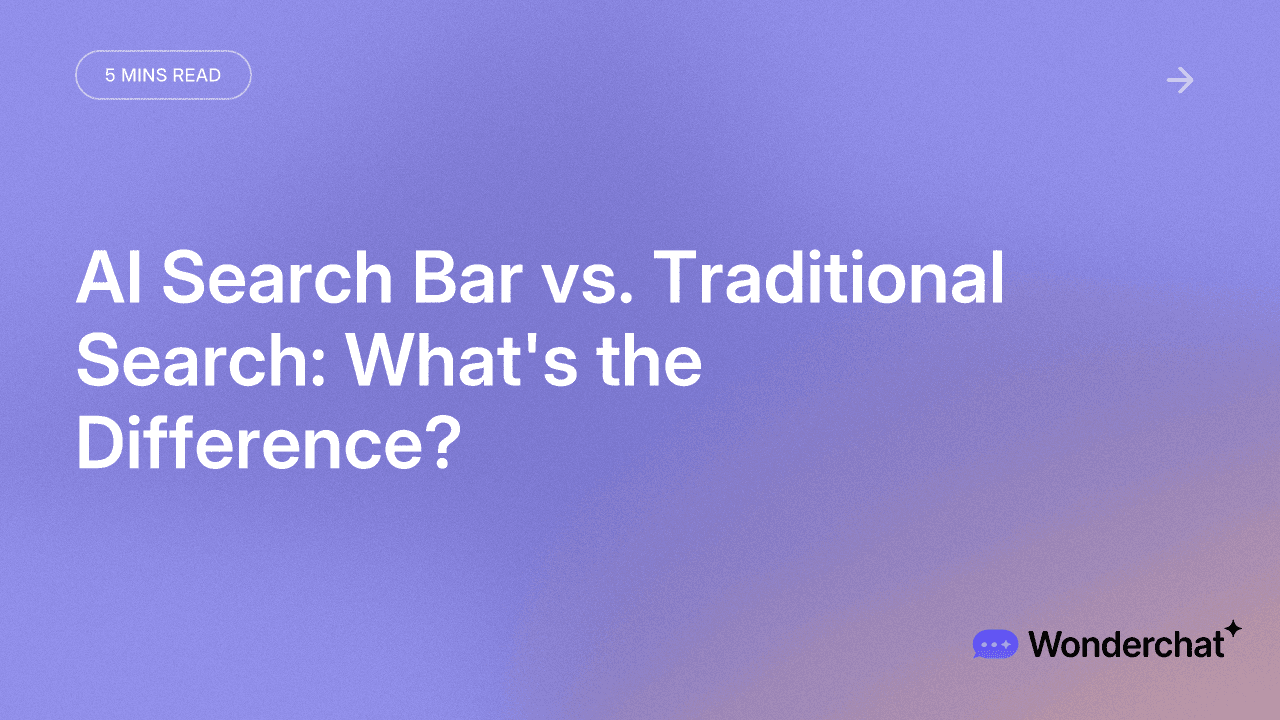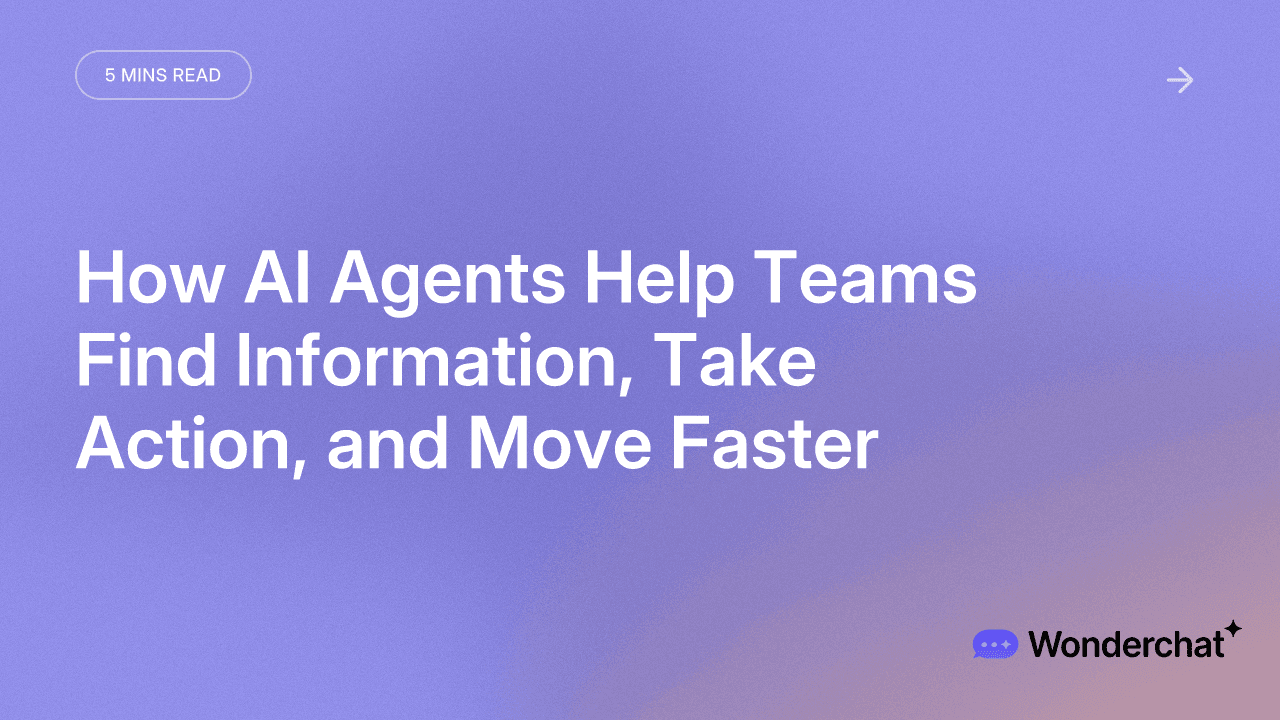Guides
Step-by-Step Guide: How to Create a Custom AI Chatbot for Your Website

Vera Sun
Nov 7, 2024
Learn how to build a custom AI chatbot for your website in just 5 minutes with this step-by-step guide.
Want to increase your website’s engagement and turn visitors into customers? A custom AI chatbot might be just the solution. While building an AI chatbot from scratch may seem overwhelming, this guide simplifies the process into easy steps you can follow.
In this post, we’ll cover the basics of website chatbots, explain how they work, and walk you through creating one - even if you’re not a coder.
Let's get going!
What Are the Different Types of Website Chatbots?
When it comes to building a website chatbot, it’s essential to know the different types available:
Rule-based chatbots
Rule-based chatbots follow predefined scripts to respond to specific commands. They can handle basic inquiries well but struggle with complex or unexpected questions.
Here's an example of an interaction:
User: "Can you help me with returns?"
Rule-based chatbot: "To process a return, please visit our Returns page."
AI-powered chatbots
AI chatbots are advanced bots that use machine learning (ML) and natural language processing (NLP) to understand user intent and answer questions intelligently. They can also learn from interactions over time, making them ideal for customer engagement.
Example of interaction with an AI chatbot:
User: "Can you help me with returns?"
AI chatbot: "Of course! Are you returning a recent order, or would you like more information on our return policy?"
Benefits of Using AI Chatbots on Your Website
Salesforce reports that 83% of service-based businesses plan to adopt chatbots within the next year. Here’s why:
24/7 Visitor Engagement
AI chatbots work around the clock, interacting with visitors in real time and increasing your sales conversions.
Problem-Solving Capabilities
Unlike rule-based bots, AI chatbots can manage complex dialogues and adapt their responses based on conversation flow and user needs.
Better Cost Savings
By reducing the need for live support, AI chatbots can help you significantly lower staffing costs.
30% Higher Conversions
Companies using chatbots have seen up to a 30% boost in conversion rates from automated responses.
These are important benefits that make AI chatbots important for any website.
How Difficult Is It to Create an AI Chatbot?
Building an AI chatbot may sound complex, but rest assured - it’s easier than you think! Platforms like Wonderchat, offer user-friendly chatbot builders with no coding needed. These tools make it simple to design and deploy a chatbot on your website in just a few minutes.
How Do I Make an AI Chatbot for My Website?
Creating a chatbot for your website is straightforward. Just follow these steps:
Step 1: Define the role of your chatbot
Decide if the chatbot will answer general FAQs, capture new leads, or assist with customer service.
Step 2: Design the conversation flow
Map out the conversation structure, including greetings, questions, and answers for the chatbot.
Step 3: Choose a chatbot development platform
Platforms like Wonderchat let you create chatbots without coding. Simply fill up a form, customize responses, and deploy it on any website.
Step 4: Integrate your chatbot with your website
Copy the chatbot code and paste it into your website’s HTML to get it activated.
Example: Building a Chatbot with Wonderchat
Let me show you how Wonderchat’s chatbot builder simplifies the process with an easy-to-use interface. You can create a chatbot profile, add custom responses, train the chatbot on specific topics, and integrate it into your website by copying and pasting a code snippet.
It’s an excellent tool for beginners who want to get a functional chatbot live in less than 5 minutes, without fuss or spending too much time.
Step-By-Step: Building a Chatbot with Wonderchat
To create your own customer service chatbot in Wonderchat, you’ll just need a few minutes and a few easy steps:
Step 1: Sign Up and Start
Begin by signing up for a free Wonderchat account.
After logging in, tap on Create Chatbot to start setting up your new custom chatbot.
Step 2: Create Your AI Chatbot Profile
In the first section, you’ll need to define your chatbot’s basic details, like personality and appearance:
Name: Give your chatbot a name that represents your brand or customer support persona
Profile Photo: Add an image to make your chatbot feel more engaging and personable

Image 1: Chatbot creation window in Wonderchat
Role of chatbot: Wonderchat offers two options here:
Pre-made prompts for a quick setup — simply select from a list of pre-defined roles like Copywriter, Salesperson, Customer Support, General or Researcher. These roles set up your chatbot to respond in specific ways, helping users know what to expect.
Custom prompts that let you write your own instructions to personalize how your chatbot interacts with users. Here you can fine-tune your chatbot’s tone and responses further.
Example of a custom prompt:
“You are [Name of Chatbot], an AI [Role of Chatbot] at [Name of Company]. Your main task is to engage visitors, offering recommendations and detailed insights into [Name of Company]'s products, delivery and features. Remember to be polite, and friendly and don't answer any questions that are not related to [Name of Company]'s products."

Image 2: Role of chatbot selection panel
Step 3: Choose Data Sources
Next, select a data source to allow your chatbot to pull the necessary knowledge to answer questions accurately. Options may include:
URL/Website: Link your website to pull relevant information.
File, Video or Document: Upload any files that help define how your brand handles inquiries, giving your chatbot a deeper understanding of your brand voice, and ways of interacting with website visitors.
Step 4: Select an AI Model and Customise Responses
Here, you’ll select an AI model that powers your chatbot’s responses. If you’re unsure, you can choose the gpt-4o-mini which is recommended for quick replies. Then, personalise the chatbot responses by writing your own custom prompts. This additional step ensures your chatbot communicates in your brand’s tone and style.
Role of chatbot: Choose from customer support, sales assistant, copywriter, researcher or input custom instructions.
Greeting and feedback messages: Write custom messages for your chatbot to use in greetings and answering questions.

Image 2: Customise AI chatbot responses
Step 5: Finalize and Launch
Once you've completed these steps, click on Create. In just a few minutes, you’ll receive an email confirmation that your chatbot is ready to go!
Step 6: Integrate Your Chatbot with Your Website
Once your chatbot gets the green light, you will need to add it to your website. Go to Actions, click More… and select Embed on Website. Wonderchat will generate a code that you'll need to copy and use it to activate the chatbot on your website.

Image 3: Wonderchat integration options
Step 7: Embed Your Chatbot into Your Website
Just copy the code snippet provided and paste it at the end of the <body> tag on your website page to activate it. And that’s it - your new AI chatbot is live and ready to greet visitors!

Image 4: Embed chatbot widget configuration
Tip: Don't Forget to Preview, Test and Make Adjustments
You also have the option to preview your chatbot by clicking on Preview Widget. This action opens a new window allowing you to see how the chatbot message will appear on your website. At this stage, if you're not happy with how your chatbot looks, you can go back and edit it further.

Image 5: Chatbot preview window
Best Practices for AI Chatbots for Websites
To maximize the effectiveness of your chatbot, it’s important to know these rules:
Train your chatbot to interact in your brand voice
Training involves adding words, phrases, and questions related to your typical customers. The more data and examples you provide, the better your chatbot will understand and respond to customer inquiries.
Personalize chatbot responses to users
Whenever possible, make your chatbot interactions feel more personal. Think of addressing users by their names and acknowledging their issues of concern.
Tip: We shared more tips on how to humanize your chatbot in this post.
Analyze chatbot data
Reviewing your chatbot performance helps you find areas for improvement, ensuring your customer service bot continues to provide better responses over time.
Conclusion
Creating a custom AI chatbot doesn’t have to be complicated. With Wonderchat, you can build a chatbot tailored to your website - even if you don’t have coding skills. This small addition can make a big impact on customer engagement, helping you turn visitors into loyal customers with ease.

